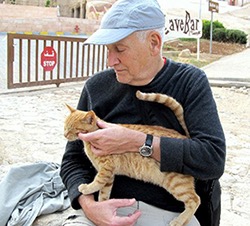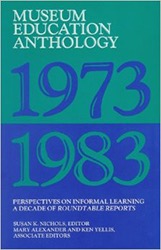Getting it Down on Paper
Part of the fun of taking on our JME40 blog project has been the necessity of diving deep into the Journal of Museum Education (JME) archives. These explorations have yielded insight into the early years of the journal and the field, the evolution of the topics and trends that have shaped our work, and the personalities that lent their time and energy to building a body of knowledge for our profession—the theory, research, and best practices that continue to guide our efforts.
Ken Yellis was one of these early leaders. “A lapsed academic,” Ken ended up in the museum field by “happy chance,” taking an NEH-funded training fellowship at the National Portrait Gallery in the early 1970s. He connected with other museum educators through his Smithsonian colleagues and quickly found himself writing for the JME’s early incarnation, Roundtable Reports.
 Over the next decade Ken’s career advanced, from fellow all the way to Curator of Education at the Portrait Gallery. His commitment to MER likewise grew. Between 1976-1987, Ken served on the editorial committee, as MER board chair, as the first “official” editor-in-chief, and edited MER’s Museum Education Anthology, 1973-1983: Perspectives on Informal Learning. Under Ken’s leadership the publication grew from a “report,” to the first peer reviewed journal focused on the theory and practice of teaching and learning in the museum. And he managed all this with exceptional charm, intelligence, and humor. Just read one of his editorials and you’ll see what I mean. His farewell editorial provides an excellent synopsis of his work during MER’s early years.
Over the next decade Ken’s career advanced, from fellow all the way to Curator of Education at the Portrait Gallery. His commitment to MER likewise grew. Between 1976-1987, Ken served on the editorial committee, as MER board chair, as the first “official” editor-in-chief, and edited MER’s Museum Education Anthology, 1973-1983: Perspectives on Informal Learning. Under Ken’s leadership the publication grew from a “report,” to the first peer reviewed journal focused on the theory and practice of teaching and learning in the museum. And he managed all this with exceptional charm, intelligence, and humor. Just read one of his editorials and you’ll see what I mean. His farewell editorial provides an excellent synopsis of his work during MER’s early years.
Earlier this year I had the pleasure of sitting down with Ken over a lunch in Providence, RI and I’m happy to report that he is as charming, thoughtful, and funny in person. Our conversation was long, meandering, and fascinating—fodder for many blog posts. But the threads that wound throughout included the need, the hunger, in the 1970s and 80s for a body of literature that could serve as “a path toward professionalism” for the men and women working in those first museum education departments. And the value and importance of “getting it down on paper”—thinking deeply, writing, and publishing about our craft.
Reflecting on the motivations driving the JME’s early champions, Ken explained:
“There was a sense that the current literature in the field was very thin or nonexistent. There was historical material that was very rich and we did a lot with that in Roundtable Reports and then the Journal. But there wasn’t much current information either available to or useful to people working in the field. We needed to build a shelf of useful stuff because nobody else was doing it.
In those days, there wasn’t a lot of attention being paid in (AAM’s) Museum News to what was going on in museum education, to describing and analyzing what was happening programmatically in museums, or to the newly emerging fields of visitor studies and evaluation. All of this contributed to a powerful desire on the part of museum educators to be considered as professionals and to have a path toward professionalism—whatever that looked like. We felt like our job was to be part of that and to support that by creating a space for long form writing in all those areas that would be crafted for and readily accessible to the field.”
Glancing over my shoulder at the tattered JME issues and mangled JME anthologies I dissected in grad school on my bookcase, I would argue that the museum education “shelf of useful stuff” has not only been built by Ken and his colleagues, but is chock full of tested theories, compelling research, and inspiring best practices shared by members of the field in the JME since 1973.
In 1983, Ken, Mary Alexander, and Susan Nichols combed through over ten of years Roundtable Reports to create MER’s first anthology of museum education writings. (The opening image features the trio at the publication party for the book.) The book flew off the shelves, feeding the hunger for information and connection. For Ken, editing the anthology was an important process of discovery, raising many important questions:
“What have we learned from all of this? How does it fit together? What sense does it make to us now in the environment that we find ourselves?
The profession is so dynamic now, so different from when we came in. In fact, it’s very different from what it was ten years ago. We felt we had to try and understand those differences and find ways to contextualize or re-contextualize the pieces we selected for readers. We also felt we had to devise editorial strategies to make it easier to understand the implications of those differences and to underscore their relationship to the way we think about what we do.
This has always been our task in a way. The self-reflectiveness of the Journal and the anthologies has been an important part of the function that MER serves in the museum education community. And I would say in the museum community writ large.”
 And so, the work continues. The JME arrives in our mailboxes three (soon to be four!) times each year and presents us with new thinking, new challenges, new inspiration. While the body of knowledge our work is grounded in has grown exponentially, there is still value—urgency even—in adding to, reflecting on, and continually questioning and testing that foundation.
And so, the work continues. The JME arrives in our mailboxes three (soon to be four!) times each year and presents us with new thinking, new challenges, new inspiration. While the body of knowledge our work is grounded in has grown exponentially, there is still value—urgency even—in adding to, reflecting on, and continually questioning and testing that foundation.
It is important to stress that WE—museum educators, practitioners—fed our own hunger. MER and the JME were founded by museum educators volunteering their time and energy to work they were passionate about. Today, 19 dedicated museum professionals volunteer to serve on the MER board and support Editor-in-Chief Cynthia Robinson in bringing you new ideas, questions, and approaches via the JME.
But we can’t do it without YOU.
The JME is for and by museum educators. Add your voice to the body of knowledge and submit an article for consideration to our Editor-in-Chief. Like Ken, I imagine you will find “getting it down on paper” to be a personally rewarding exercise. And you will join an impressive group of educators and writers who have shaped and continue to expand the conversation around the value of our work.
Don’t know where to start? I leave you with Ken’s own words, a great piece from the spring 1985 issue of the JME, for inspiration.
Elisabeth Nevins is the principal of Seed Education Consulting in Boston, working with museums and historic sites to create engaging and relevant learning experiences for visitors. She serves on the board of the Museum Education Roundtable and as a reviewer and cover photo editor for the Journal of Museum Education. She tweets as @seededucation.

